Eastern Cicada Killer
![[1]](/images/3/3e/Cicada-killer.jpg)
| |
| Kingdom: | Animalia |
|---|---|
| Phylum: | Arthropoda |
| Class: | Insecta |
| Order: | Hymenoptera |
| Family: | Crabronidae |
| Genus: | Sphecius |
| Species: | Sphecius Speciosus |
Description
The Eastern Cicada Killer (Specius speciosus) is a large solitary digger wasp belonging to the crabronidae family. They are one of the largest wasp species in North America. Adults can be 1.5cm to 5cm long, with females tending to be larger than the males. Their thoraxes are reddish-brown and black with tiny, rust colored hairs. The abdomen is banded yellow and black, giving them similar appearances to yellowjackets and other wasps. The wings are large, brown colored and translucent. Their eyes are quite large, with a reddish brown color. Eastern Cicada Killer have 6 legs that can range from yellow to red. Both female and male abdomens end in a tip, giving the appearance of a stinger, but only females actually have the ability to produce a sting.
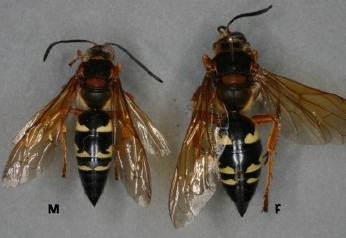
Habitat and Range
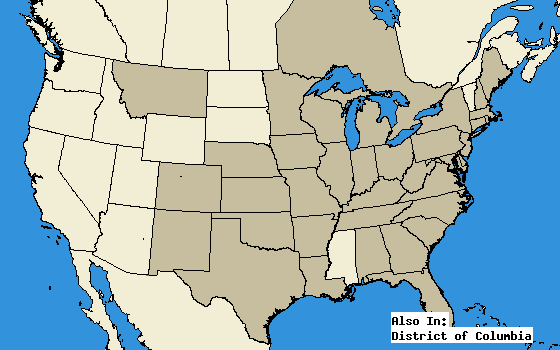
Eastern Cicada Killers can be found all along eastern North America. They prefer well-drained, loose, sandy soils on southward facing slopes to dig their burrows for nesting. These nests can be found in forests or grasslands and also in more urban settings like parks and gardens. The wasp prefers bare soil that typically is exposed to sunlight for their burrow placement. These burrows can be 25cm to 50cm deep and typically 1.5cm wide. The nests created inside can have 5 to 6 cells that act as nurseries, with females able to support up to 16 larvae in one nest.
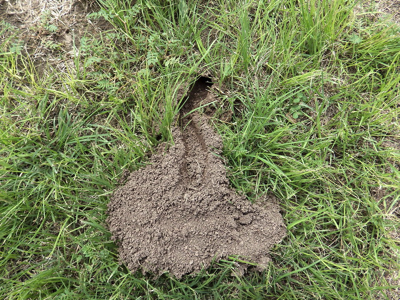
Behavior and Life Cycle
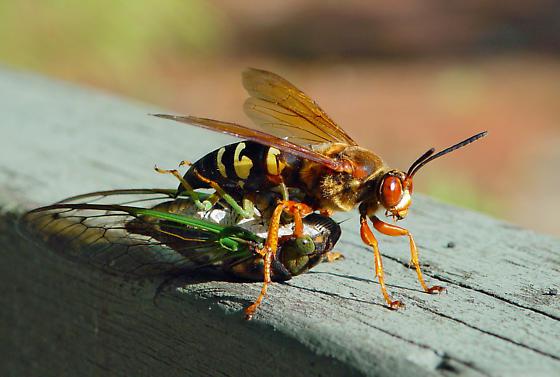
The Eastern Cicada Killer are solitary, not forming large hives like bees or hornets. Males can be seen in groups, however this is due to them being highly terrotorial and fighting for space. Males will attempt to court any females in their terriotry, and if successful, the two will mate. After mating, the female will then begin to look for a spot to burrow for a nest. Multiple females can create and share a single burrow, while having their own cells within the nest. Cicada Killer adults do not actually eat cicadas, as thier main food source is actually nectar from flowers. These wasps get their name due to their parasitic larval stage. After the nest is complete and ready for larva, the female will venture off to find a cicada. Once found, the females use their stinger to paralyze the cicada, then dragging it back to its burrow. This is a remarkable feat for these wasps, as cicadas are typically much larger then them. The live cicada is stored in one of the cells, where the female cicada killer will then lay an egg on its prey before closing the cell off. Female eggs have been noted to sometimes recieve two cicadas within their cells, as they're larger and require more energy[1].
These eggs will hatch in 2 to 3 days, in which the larvae will burrow into the still live cicada and begin to devour its internal organs. The cicada needs to be alive as long as possible due to the risk of spoiling being deadly to the larvae. After they finish feeding, the larvae will then spin a cocoon to stay in. They stay in these cocoons over the winter, spending 10-11 months underground. Around mid-July, adults begin to emerge from these burrows. Males emerge first, in order to start the competition over territory and mating before females arrive. Females tend to emerge a week or two later, when mating will also begin. Once a female is mated, she will not mate with another male, and will begin to find a place to burrow for a nest. Males tend to die shortly after mating, while females die after laying eggs. Both adult populations tend to all be dead by mid-September, where their larvae will wait underground to repeat the process come July. This means that each year is a completely new generation of Eastern Cicada Killers.
Eastern Cicada Killers pose no threat to humans. Unlike eusocial hymenoptera, Eastern Cicada Killers do not sting out of protection for their nests. Males tend to patrol their territory, and because of this, they tend to investigate any type of movement. This can be quite intimidating for a person as the Eastern Cicada Killer is quite large and loud, and will begin to hover around and maybe even land on them. This can be seen as an aggressive behavior, however females tend to not sting unless handled roughly, and males possess no stinger at all.
Ecological Role
Eastern Cicada Killers can play multiple roles within an ecosystem. Firstly they can act as a control on cicada population numbers within a forest. Cicadas can cause damage to deciduous forests when their populations grow too large, as female cicadas use these trees to lay their eggs. Eastern Cicada Killers rely solely on these cicadas for their natural life cycle, and their predation on them helps numbers stay from growing into a problem for the larger ecosystem. Eastern Cicada Killers also acts as pollinators, as they feed on the nectar of flowers and get pollen stuck to them. Eastern Cicada Killers are also the host species for the Red Velvet Ant (although it is a type of wasp). The Red Velvet Ant will lay its eggs in an Eastern Cicada Killers nest cell. When the Cicada Killers begin to pupate, the Red Velvet Ant larvae then begins to feed on it.
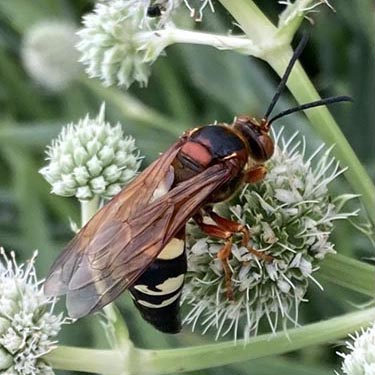
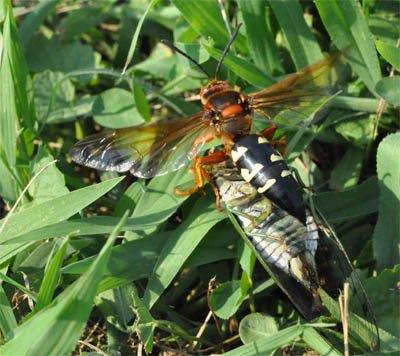
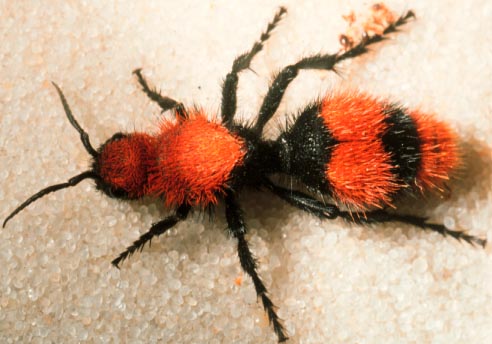
References
[2] [1] [3] [4] [5] [6] [7] [8]
- ↑ 1.0 1.1 Coelho, Joseph R. 1997. “Sexual Size Dimorphism and Flight Behavior in Cicada Killers, Sphecius Speciosus.” Oikos 79 (2): 371–75. https://doi.org/10.2307/3546021..
- ↑ Carlton, Christopher E. 2024. “Sphecius Speciosus, Eastern Cicada Killer (Hymenoptera: Crabronidae).” LSU AgCenter. February 16, 2024. https://www.lsuagcenter.com/profiles/madeleinestout/articles/page1685734764096.
- ↑ Coelho, J.R. 1998. “(PDF) An Acoustical and Physiological Analysis of Buzzing in Cicada Killer Wasps (Sphecius Speciosus ).” ResearchGate, July. https://doi.org/10.1007/s003590050297.
- ↑ Missouri Department of Conservation. n.d. “Eastern Cicada-Killer Wasp.” Missouri Department of Conservation. Accessed March 31, 2025. https://mdc.mo.gov/discover-nature/field-guide/eastern-cicada-killer-wasp.
- ↑ Gibb, Timothy. 2018. “Cicada Killers.” March 2018. https://extension.entm.purdue.edu/publications/E-254/E-254.html.
- ↑ Gist, Kelson. n.d. “Sphecius Speciosus (Cicada Killer).” Animal Diversity Web. Accessed March 31, 2025. https://animaldiversity.org/accounts/Sphecius_speciosus/.
- ↑ Holliday. 2014. “Biology of Cicada Killer Wasps | Prof. Chuck Holliday’s Www Page at Lafayette College.” October 22, 2014. http://web.archive.org/web/20141022032916/http://sites.lafayette.edu/hollidac/research/biology-of-cicada-killer-wasps/.
- ↑ “Species Sphecius Speciosus - Eastern Cicada-Killer Wasp.” n.d. Accessed March 31, 2025. https://bugguide.net/node/view/514.